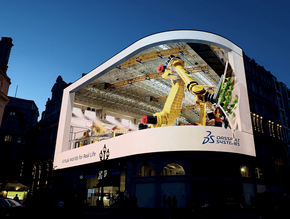Infosys’ digital twins pushing businesses closer to net-zero

Raghav Karinja is the Global Head of Engineering, IOT and Blockchain practice at IT service Infosys. Based in Bangalore, India, Infosys was founded in 1981, with a goal to be a leader in next-generation digital services and consulting. Now, Infosys has 343,000 employees globally and a revenue of USD$1bn.
In his role, Karinja helps clients in their digital transformation journey across their product life cycle. With more than two decades of consulting and programme leadership experience, he continues to be a hands-on practitioner helping clients navigate their transformation journey, through initiatives like smart connected products and operations, digital threads, servitisation and smart spaces.
Here, he discusses how the manufacturing sector can reach net zero, the role of digital twins and innovative technology solutions.
Net zero goals in manufacturing
Infrastructure development in the past and for the cities of tomorrow promises economic and social advancements across communities. However, Karinja points out that historically, it also drives up carbon emissions and adversely impacts the environment in myriad ways.
“Amidst a global recognition of the climate change crisis, it is now an organisational imperative to have sustainability principles at the core of their infrastructure development initiatives and with a target date of 2044, nearly three-quarters of organisations have set a net-zero goal,” explains Karinja.
Organisations that are committed to sustainability are increasingly efficient, use fewer resources, create less waste to generate more revenue and produce higher returns on investment.
However, Karinja knows that one of the challenges of investing in sustainability has been the lack of insight into the organisational processes.
“Digital twins can provide real-time insights into any physical entity, subsystem, system, process, or an ecosystem, allowing for a transparent validation basis for the strategic KPIs. It helps in monitoring and optimising the sustainability performance indicators in real-time or near real-time across the life of an asset.”
The potential of digital twins in manufacturing
Despite being around for decades, digital twin technology is now increasingly being harnessed across industries and geographies. It is being adopted by organisations to design and build more sustainable infrastructure for the future that aligns with their ESG considerations.
Karinja sees that digital twin technologies also have huge potential in planning smart cities and their ecosystem which includes factories, infrastructure, transport, communication networks and more.
“Right from the design phase, the digital twin helps evaluate various trade off studies on materials, designs, and other processes to improve the fidelity of models substantially and arrive at the best possible options. These ‘As designed KPIs’ of assets can be continuously evaluated with the ‘As constructed KPIs’ during the construction phase – reducing the gaps if any in a short time with minimal resources.
“Digital twins enable better collaboration and real-time information exchange between the design department and the construction site which improves stakeholder experience, project efficiency, and quality of work. Additionally, since for high value assets, the operations phase continues for several decades, comparing ‘As designed KPIs’ and ‘As operated KPIs’ via digital twins allows real-time insights and information on the operations and health of the asset. This helps in managing the cost of operations, energy consumption, carbon footprint, and waste management.”
Driving sustainability with digitalisation
According to projections by the United Nations, two-thirds of the planet’s population will be in urban areas by 2050. The number of megacities is also expected to grow from 31 today to 43 by 2030. One of the critical needs therefore is to reduce the exponentially growing carbon footprint attributed to modern society and restore planetary stability.
“Using digitalisation as a core fabric to facilitate transformations across the built environments helps in developing environmental resilience. Acceleration of responsible, people-centred digitalisation can identify, design and implement and realise practical sustainability megatrends. Designing and building infrastructure in a digital world enables organisations to track carbon emissions and conserve resources more efficiently.”
Karinja sees that a digital infrastructure is central to the net zero push enabled by sustainable supply chains, smart monitoring and controls, as well as strategic implementation across all aspects of cities and communities to transform the urban landscape, including human settlements, natural environment and the built environment.
“To that end, the United Cities Global Framework was developed and tested in extensive cooperation with the private sector, investors and finance institutions, international agencies, academic institutions, NGOs and local and central governments,” explains Karinja. “It includes setting up city innovation labs, enabling ecosystem labs to scale green industrial city projects, developing partnerships with other global actors, ensuring citizen involvement and implementing urban operations with digital twins.”
Innovative technology solutions and advanced city simulations allow for a systematic and holistic approach to urban development that aligns with climate targets and sustainability development goals. Advanced city simulation labs also enable data-driven understanding of end-to-end operations to make financial and risk assessments sense of sustainability goals.
“While innovation by private enterprises and investors push public institutions to act with speed and scale, public-private partnerships (PPPs) are essential for taking a holistic approach towards ESG,” says Karinja. “PPPs bring together skillsets from the private sector and resources at scale from the public sector.
“Digital twins are a key technology to drive sustainability across the enterprise and provides holistic value on sustainability by balancing social, environmental and economic imperatives while allowing businesses to benefit from sustainable and circular economy designs in the long term.”






